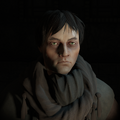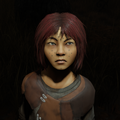The Kin (endonymously the "Khatanghe" in Pathologic 2) are the indigenous people of the Steppe, living both in the Town as well as independently throughout the Steppe. While containing multiple clans(citation needed), they are often collected into one name, "the Kin".
The Kin play a core role in the story of Pathologic. Their beliefs and practises influence the decisions of the Haruspex, and to a lesser extent, the Changeling. They are a deeply spiritual people, with some of their traditions adopted by the Town (such as frowning upon cutting flesh). Many of the Kin who live in Town work under the Bull Enterprise, such as Overseer Tycheek and Oyun. Those who do not remain nomadic, or live in settlements such as Shekhen.
A community-made informational resource on the Kin's language can be found on the Steppe Language page.
| “ | The Kin are your people. The children of Boddho, the steppe people that work here day and night. It is from their flesh and blood, as well as from the bones and skins of the bulls, that the town is being built—for several generations now. The houses grow from their bones and the trees are fed with their sweat. | „ |
People
Kinsfolk
The Kin are comprised of Kayura, Pochard, and Siskin townsfolk; they also include Herb Brides and Worms. In Pathologic, Butchers are included among the Kinsfolk.
Herb Brides
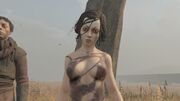
A Herb Bride in the Pathologic 2 prologue
- See Herb Brides.
Herb Brides are young women who communicate with the Earth and perform intricate, spiritual dances to bring herbs to the surface. Herb Brides are considered deeply sacred, as they are crucial to a good harvest. Their dresses often split open as they dance, due to the passion and intensity brought forward.
Some Herb Brides who live in the Town have found work at the Broken Heart as dancers. Most Herb Brides who remain in the Town live in areas such as the Crude Sprawl, in their own housing or at Aspity's Hospice, though some Brides can be met in the centre parts of the Town in the Maw district.
Herb Brides and a Worm
Herb Brides by Isidor Burakh's House
Nara in the Steppe
Worms
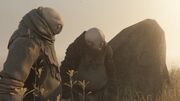
Two Worms in the Steppe in Pathologic 2
- See Worms.
Worms are creatures of the Steppe that serve as gatherers in the Kin. They are described as "half-people, crude and unshapely and unfinished", and are considered to be what remains after the Earth creates Men.
Many worms live in yurts in the Steppe. However, according to townsfolk, Worms don't usually stay in place for long — they travel and break camps for the night. Some also work in Town as ferrymen, who ferry passengers up the Gorkhon river. Some Worms live near the Town, though they are few and far between, located mostly within the Crude Sprawl.
Worms are often called odongh, the Steppe word for a shepherd that has the duty of herding cattle between the Steppe and The Abattoir. It is translated as "he who holds Him by the horns". However, the meanings of the words aren't interchangeable and odongh can also refer to anyone of the Kin of the same profession.
A Worm alongside Herb Brides
Butchers
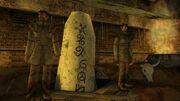
Two Butchers inside Taya Tycheek's room in the Termitary.
- See Butchers.
Butchers are workers of the Abattoir, who are tasked with the the slaughter of bulls and the processing of their meat. They are referred to by the Kin as "Yargachin", which is meant to refer to both a butcher and a surgeon.
While butchers are traditionally able to dissect bulls, they are still forbidden from the dissection of human bodies. According to tradition, they are also the only ones permitted to dig in the earth.
Butchers only appear in Pathologic. In Pathologic 2, they are instead replaced by a larger cast of people to represent the Kin, but there still remains references to people with the same occupation of the original Butchers.
Butchers in Taya Tycheek's room in The Termitary
History
Industrialization
- Although the Kin participates heavily in the meat industry of the Town, when the railroad was first built it was treated with great suspicion. Sometimes the rails were even sabotaged during their construction, or trains would just disappear. The Olgimskys and other leaders of the Town made no real attempt to do anything about this. Those from the Capital consider the rail that leads to the Town to be cursed.[1]
For several decades, the Kin have been under the employment of the Olgimsky family. Those under their employment live within the Termitary, a communal housing project that gives workers of the Bull Enterprise dedicated shelter for themselves and their families. The Bull Enterprise is responsible for cutting, processing, packaging, and selling meat, primarily cattle. Many groceries have popped up around the Termitary to profit off of the meat being sold. Most of the product is sent off to the Capital via train.
The Olgimsky leaders, such as Big Vlad, proclaim that the practises of the Bull Enterprise gives the Kin meaning and purpose. The business model allows for an imbalance of power, where the Kin are seen as ungrateful workers if they push back against the manipulated generosity of the Olgimsky family. Leaders have been put in place by Big Vlad to ensure his control over his workers, such as Overseer Tycheek and Oyun.
| “ | Here’s something that’s very important to be aware of. The Kin is falling apart and decaying. They’re in a similar state to late-19th-century Native Americans: the old chieftains are still alive, but young people have been going to work at white man’s stone quarries, brothels and railroad construction sites for a while now. The rituals and customs have long lost their vividness, their direct links to reality, indeed their meaning. | „ |
| — From the game's design documents |
Culture
Spiritual Beliefs
Many of the Kin's beliefs remain within their culture, though some aspects have been adopted by the Town - such as frowning upon sharp objects and cutting other people. Many non-Kinsfolk within Town who abide by these beliefs treat them as old superstitions to adhere by rather than a sense of religious beliefs. Those who live within the Abattoir claim to be "closer" to the Earth, and as such, abide by the traditions and beliefs of the Kin far more closely than even those who live within Shekhen and outside of Town. The connection that those within the Abattoir claim to hold is likely brought forward due to a lack of outside influence, be it dangers such as colonization, or natural life such as multiculturalism.
Menkhu
- The menkhu—"Those Who Know The Lines"—are a special caste who are allowed to open bodies. While menkhu are notable in-game for their ability to dissect human bodies, their main purpose seems to be the dissection of bulls.
- The right to open bodies is passed down through family inheritance. Isidor Burakh is an esteemed menkhu, and he passes this knowledge to his son, Artemy.
Boddho and the Earth
Boddho
- A female personification of the Earth, styled as a mother. She is similar to Bos Turokh (as the progenitor of existence) and there is in-game debate over the creation story. The land is her body and thus cannot be excavated or dug into.
- Boddho is said to have created all life and considers them all as her children.
- The origin of Boddho's name is unclear, but it may have been taken from 'cattle' in several steppe languages in the real world (bod in Mongolian), or from bod (бод), which means 'sting' or 'needle' in several Slavic languages.[2] [3]
Children of Boddho
- While Boddho created all life, only Steppe natives and the "spirits conjured by the earth" are formally considered to be "Children of Boddho."
- They sacrifice blood to the ground to help Boddho thrive and grow, and believe in the preservation of the laws of nature. Herb brides too dance, letting their bare feet touch mother Boddho in an almost loving caress. This dancing prompts growth of twyre.
- The process of sacrificing blood to Boddho is a mutual transaction, as it too prompts growth of blades of twyre.
Creation Story
Bos Turokh
- Bos Turokh is a bull deity known as the 'World Bull', and the central figure in Steppe culture. He created the universe after consuming Suok, the personification of evil. He encompasses everything. His earthly manifestation is known as Bos Primigenius, which is the Latin name for the extinct species of cattle, the aurochs (described as a half-human, half-bull hybrid in the world of Pathologic). There are said to be very few auroch left in existence.[4]
- Bos (from Latin bōs: cow, ox) is the name of the genus of all types of cattle, and in Latin primigenius means firstborn.[5] [6] Tur (тур) is the Russian word for an aurochs.[7]
- See Bos Turokh.
Suok
| “ | "She made a body for herself out of bones and clay. She drank a soul for herself from the dark waters. She left her handprints on the walls. She filled the air with her spittle. She fed the spoilt blood to the earth."
from The Song of Suok's Consolation |
„ |
| — Pathologic Board Game[8] |
- Suok is a void of consuming darkness which Bos Turokh devoured, smothering her progression with his body. She now resides underground, within the World Bull, and is said to be the source all evil things. She is sometimes referred to as "Mother" or "Stepmother" Suok. She is equated with death, and blood is sacrificed in the Circle of Blood to sate her. She, or perhaps her shabnak, is described in the Tales as a two-headed being with an eyeless black face and a noseless white face in constant conflict with each other.
- The real-world etymological basis of this word is unclear; it could be derived from the Russian word sukhoy (сухой), 'dry'.[9] Fictionally, as Ashen Swish is named Bardo Suok with the meaning "the darkness of the depths," Suok's name might be synonymous with either "darkness" or "the depths."
Superstitions
Shabnak-adyr
- An evil, feminine spirit said to be made of clay and bone. She devours people and spreads the Sand Plague. She is infamous among the townsfolk.
- Prior to the start of the game, Isidor Burakh is said to have seen her shortly before dying, and thus his and Simon Kain's deaths are initially blamed on her.
- The origin of the name Shabnak-adyr may be in shab (šab, шаб), which means 'night' in Persian and related languages, and ad (ад), which is Mongolian for 'demon' and Russian for 'hell'.[10]
Albino
- See Albino.
Morality
Customs
- Neither the Earth nor the human body was made to be cut into. The Earth is sacred, so excavation too deep into the "earth's flesh" is a severe crime. As such, wells and organized digging are prohibited except by butchers.
- Only Butchers may cut into cattle, and cutting into the body of a human is both a capital offense and a powerful taboo. While the menkhu are traditionally able to open human bodies, they are still regarded with some distaste.
The Law
- The natural "law" of the Earth. The Law is considered to be the will of Boddho herself; Steppe spirits are said to be created in order to fulfill it. The Changeling and her Bound all share a common goal in the preservation of the Law, though it does not appear to be the same will of Boddho. The use of the term "the Law" seems to ultimately mean the logic and rules of the universe, whatever the core of that "universe" is.
- Since the Polyhedron had to be planted so deeply in the ground, it is considered to defy the law and rule of the universe, and the most prominent example of "the breaking of the Law." While it is despised both as a desecration of Boddho and scientific reason, those who seek its destruction are not inherent allies, as evident by the Haruspex Route and the Changeling herself.
Gallery
The Ragi Barrow
Entrance to the Abattoir, the Gorge
The Bone Stake Lot
Khatangher gathered by the train tracks
Khatangher in Aspity's Hospice
The bull heads at the entrance of Shekhen
Uur Heelu, known as the Gumstone
The Ring of Suok in the opening of Pathologic 2
Animation Videos
Official Art
Notes
- While largely fictionalized, the in-game language of the Kin seems to be built around real-world languages, including Russian and Buryati, as well as Mongolic and Turkic languages. Certain words seem to be lifted from German, as well.
- Additionally, certain aspects of the Kin's culture take inspiration from the Buryat, real life indigenous people who live in Siberia, Mongolia, and Inner Mongolia in northern China.[11]
References
| |||||||||||||||||||||||||||||
 Welcome to the new Dark Mode! If you'd like to browse in Light Mode, head over to your
Welcome to the new Dark Mode! If you'd like to browse in Light Mode, head over to your 

